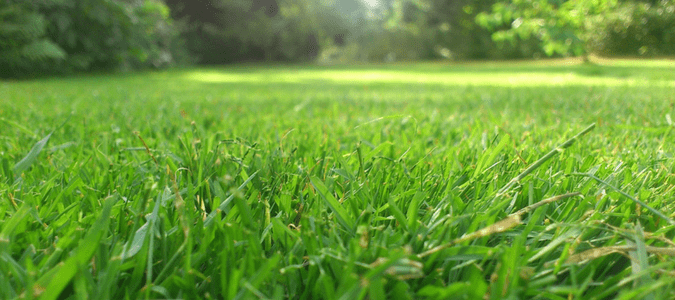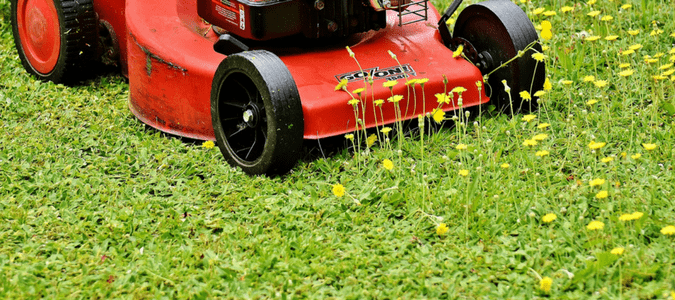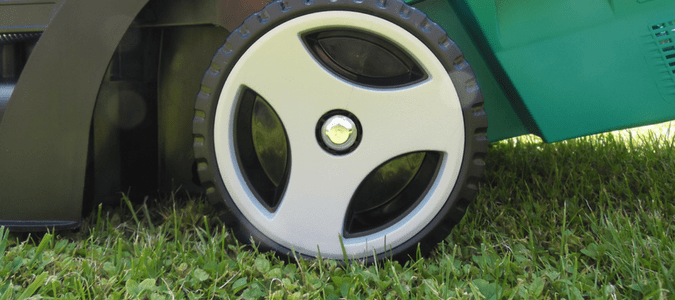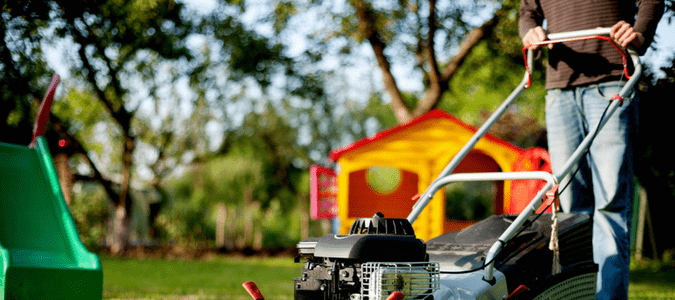
The end of winter means one thing for many of us in the Southern states: the brutal heat of summer isn’t far away. To look on the bright side, everything comes to life again during the springtime. Insects and other animals emerge from their winter hiding spots and plants and flowers begin to bloom once more.
Just like all other living things in your backyard, your grass will also begin to grow. While your initial inclination might be to get out the lawnmower on the first day of sunshine and warmth, knowing how and when to start mowing your lawn will be the first step in giving your grass the care it needs to survive our dry and hot summers.
In this post, we’ll dive into the dos and don’ts of mowing your grass, including how to properly cut and care for your lawn after the winter months up until the growth of your grass slows down.
What You’ll Learn:
- The First Mow Of The Season
- The Most Efficient Lawn Mowing Patterns To Adopt
- The Best Lawn Mowing Tips And Techniques
- The Last Grass Cut Of The Year

The First Mow Of The Season
To best understand when you should plan your first mow of the season, consider when you last mowed your lawn. Chances are, it was before the temperatures dropped. This is important, as the last grass cutting in the fall prepares the grass for its dormant period so that we know the best time to mow the lawn in spring.
After you consider how long your grass has been dormant, you’ll want to consider what type of grass you have in your lawn. Warm-season grasses, like bermudagrass and buffalograss, grow in the spring or summer months, entering a dormant period in late fall. As such, these grass types will need to have their final cut of the season around late October. Alternatively, cold-season grasses, like Kentucky bluegrass and hard fescue grass, grow in both the summer and winter months, which means homeowners often will need to cut their grass in both late May and November or December.
Once you’ve determined when you last cut your grass, and if in fact you did so at the suggested time as we mentioned above, there are a few other factors to consider in planning when to start mowing your lawn. Before you get started, we recommend raking. Doing so before you mow will allow you to pull up any thatch that may have accumulated over the winter. In addition, raking will highlight any dead areas that will need additional resources and attention once you begin working on your yard.
Next, you’ll want to look at the length of your grass. Naturally, your grass will be longer if the last cut was in late October compared to November or December. But a good rule to follow when planning the first mow of the season is to wait for the grass to measure at least three inches tall. Cutting your grass before it’s grown an appropriate height can make it more susceptible to disease, injure the plant itself and also damage the roots.
Another consideration is your location, as where you live directly affects when to start cutting grass in the spring. That’s because locations with warmer climates will naturally see a frostless lawn sooner than cities in northern states, thus, allowing homeowners to fertilize their lawns sooner than others. If you have cold-weather grass, you might not have to apply another layer of fertilizer again in the spring if you already did so before the winter months. That’s because cold-weather grasses can hold their fertilizer through the winter and into the spring and summer months. On the other hand, if you have warm-weather grasses, chances are you may need to apply a fresh layer of fertilizer, as these grasses will begin to soak up the nutrients as soon as the weather gets warmer.
Generally speaking, homeowners should begin fertilizing their grass once it turns green and after they have the soil tested to determine what nutrients their lawn needs after the winter months. If you decide to not have your soil tested, using a complete fertilizer with a 3-1-2 ratio of nitrogen, phosphorus and potassium gives you the best chance of getting your lawn the nutrients it needs that is often lacking in our soils.

The Most Efficient Lawn Mowing Patterns To Adopt
Have you ever noticed a lawn that looks like it has checkers or stripes running across it? It’s not an optical illusion, but instead the result of an effective lawn mowing pattern technique. While it might seem like this look is reserved for baseball fields and parks, accomplishing this look is easy to do at home in your own backyard. Simply put, blades bent toward you appear to be darker, while blades bent in the opposite direction seem a lighter color green.
To create that professional look, and bend the blades accordingly, you’ll want to ensure you’re mowing in straight lines, so a good place to start is to mow your first “line” next to a straight sidewalk or driveway, looking at least 10 feet in front of you while moving forward. Looking ahead of the mower will help create straight lines and not accidentally veer a bit to the left or right. At the end of the row, lift the mower deck while turning and begin to mow in the opposite direction, directly next to the row you just finished mowing. To create a checkerboard look, mow the lawn for a second time, starting this time at a 90 degree angle to your first row.
Not only is a checkerboard pattern one of the best ways to mow your lawn, but there are also additional benefits in doing so. Unfortunately, mowing your lawn the same way every time can, over time, wear out different areas of grass, causing dead spots and allowing for weeds to grow. Additionally, using the same mowing patterns and techniques causes the grass to compact, which makes it harder for healthy grass to grow.

The Best Lawn Mowing Tips And Techniques
As we mentioned above, you’ll want to wait until your grass is at least three inches tall to start mowing more frequently. So, at that point, how often should you mow your lawn? The answer varies, but it is possible to overdo it. Be cognizant of the approximate height of the grass you cut, too, removing no more than one-third of the blade’s length. Cutting grass too short is the main mistake homeowners make when attempting to apply a lawn mowing pattern technique. While cutting your grass shorter than recommended won’t cause any severe issues if done on occasion, repeated close mowing can result in an unhealthy, brown lawn and other harmful side effects.
Other potential consequences from repeated close mowing include injury to the crown and reduction of the blade’s surface area, which results in the plant being unable to produce food through photosynthesis, as well as heightened risks for pests, disease, soil compaction, and increased capacity for weeds and weed growth.
To ensure that you’re avoiding the pitfalls mentioned above, and that you’re effectively and efficiently caring for your lawn, here are a few pieces of advice to follow when mowing:
- Avoid mowing your grass when it’s wet, as the blades will be less likely to clump when cut.
- Aim for the best time to cut grass: hours of peak sunlight and heat, not in the morning when your lawn may be damp or at night or at dusk, when it’s more difficult to see.
- Change your mowing pattern each time you mow, as we mentioned, to avoid soil compaction and other potential issues.
- Keep mower blades sharp and balanced to make the most effective cuts.
- Mow your lawn while moving forward to save time having to go back and fix any areas you missed if you weren’t mowing as efficiently, in a straight line.
- If you have both shaded and non-shaded areas, mow the grass in shaded areas higher than those with direct sunlight. This allows your grass a bit more surface area to soak up the available sunshine in these areas that might receive only infrequent or filtered periods of sunshine.
- Leave the grass clippings on your lawn after mowing, since they will decompose quickly and can return important nutrients to the soil. If don’t like the way that looks, you can also compost leaf clippings so that they don’t go to waste.
- Adjust your mowing frequency, based on the type of grass you have, the season and your watering schedule. During the spring months, that might mean as often as once a week, while you might not mow at all during the winter.
When considering how to mow your lawn, homeowners should also remember a few safety rules to follow when operating the equipment used to mow your lawn. Whether it be an original push mower, a walk behind power lawn mower or a riding lawn mower, safety is always a primary concern. First off, spend some time learning more about the machine you’ll be using and be sure you know how to operate it before you even take a step outside. Next, remove any debris from your lawn and ensure children, pets and others are at a safe distance while you are working. You’ll also want to wear the proper clothing, including eye and hearing protection and any additional safety gear to protect yourself from both the machine and warm temperatures.

The Last Grass Cut Of The Year
When to start mowing your lawn in the spring ultimately depends on when you last cut it, among other factors, such as grass type, your location’s climate and the length of the grass at spring’s onset.
Most lawns have warm-season grasses, like bermudagrass and buffalograss, which grow in the spring or summer months. With a dormant period occurring in late fall, these grasses will need to have their final cut of the season around late October. Early November can also work, especially if the blades have not yet grown at least three inches tall by late October.
If you decide to overseed during the winter months to crowd out weeds or just to keep a greener color when temperatures drop, you will probably be cutting your grass throughout the colder months and watering more regularly than during an average year. Dormant bermudagrass should still be watered during the winter months, particularly if the weather stays windy, warm and dry. Unless you are overseeding, you won’t need to fertilize your grass from about September until March. You’ll likely see fewer pests in your lawn in general during the winter months, and you may elect to apply herbicides if you notice weeds crop up during this time.
Your Neighborhood Experts In Lawn Care
At ABC Home & Commercial Services, we understand that finding the time and having all the right equipment to mow your lawn can often prove difficult and stressful. That’s where we come in. Our team of experts are ready and eager to assist you for all your lawn service needs. Whether it’s mowing your lawn, inspecting its health, planning the first mow of the season or even designing the backyard of your dreams, we’re happy to help. If you need a helping hand getting your yard in tip-top shape before the hotter days of summer arrive, our experts are available to help.
